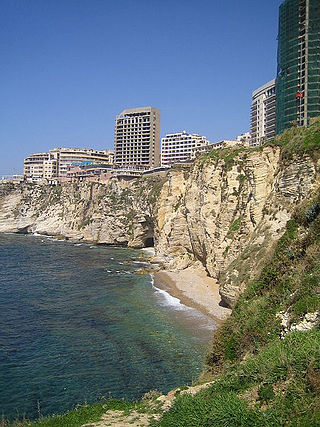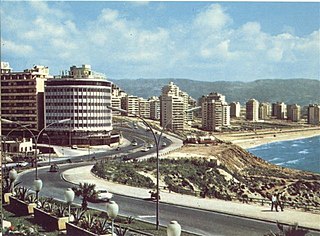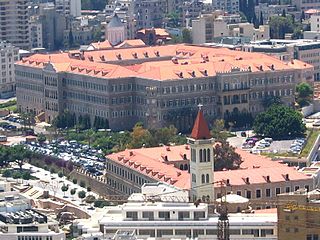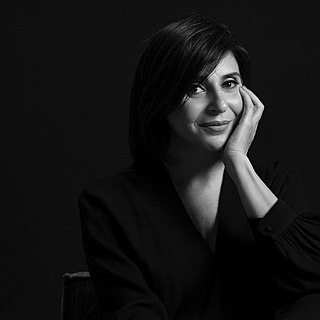
Avenue de Paris is a seaside, palm-lined street in Beirut, Lebanon. The avenue, which forms with Avenue General de Gaulle the Corniche Beirut promenade, is popular with rollerbladers, cyclists and joggers. [1] [2]

Avenue de Paris is a seaside, palm-lined street in Beirut, Lebanon. The avenue, which forms with Avenue General de Gaulle the Corniche Beirut promenade, is popular with rollerbladers, cyclists and joggers. [1] [2]
The municipality of Beirut initiated in 2001 an embellishment of the Avenue de Paris section of the Corniche Beirut, a project that was conceived and designed by Lebanese artist, Lena Kelekian. The project included the replacement of the 76 cement benches with new ones covered with colorful cut ceramics as well as a Mega Chessboard on the widest section of the sidewalk. [3]
The U.S. embassy, which was attacked on April 8, 1983, was located on Avenue de Paris. [4] The embassy is now located in Awkar, a hilly suburb north of Beirut. [5]

Beirut is the capital and largest city of Lebanon. As of 2014, Greater Beirut has a population of 2.5 million, which makes it the third-largest city in the Levant region and the thirteenth-largest in the Arab world. The city is situated on a peninsula at the midpoint of Lebanon's Mediterranean coast. Beirut has been inhabited for more than 5,000 years, making it one of the oldest cities in the world.

Achrafieh is an upper-class area in eastern Beirut, Lebanon. In strictly administrative terms, the name refers to a sector (secteur) centred on Sassine Square, the highest point in the city, as well as a broader quarter (quartier). In popular parlance, however, Achrafieh refers to the whole hill that rises above Gemmayze in the north and extends to Badaro in the south, and includes the Rmeil quarter.

The Beirut Central District is the historical and geographical core of Beirut, the capital of Lebanon. Also called downtown Beirut, it has been described as the “vibrant financial, commercial, and administrative hub of the country.” It is thousands of years old, with a traditional focus of business, finance, culture, and leisure.
Joseph Philippe Karam (1923–1976) was a Lebanese architect. He was a leading figure of modern architecture in Lebanon during the country's golden era, 1945 to 1975. Karam founded his practice the Atelier d'Architecture Joseph Philippe Karam in the late 1940s.
Rue Clemenceau is a commercial and residential street in Beirut, Lebanon. The street was named in honor of Georges Clemenceau who accepted the post of premier of France in 1917 during World War I. The neighborhood straddling Clemenceau Street was prior to the war one of the most cosmopolitan areas of the city and home to Christians, Muslims, Druze and Jews.

Raouché is a residential and commercial neighborhood in Beirut, Lebanon. It is known for its upscale apartment buildings, numerous restaurants, and cliff-side cafés that line Avenue de Paris, which forms part of the Corniche Beirut.

The Corniche Beirut is a seaside promenade in the Central District of Beirut, Lebanon. Lined with palm trees, the waterfront esplanade has views of the Mediterranean and the summits of Mount Lebanon to the east. Corniche Beirut has its foundation in the Avenue des Français, which was built during the period of the Mandate for Syria and the Lebanon along the seafront that extended from the old town.

Ramlet al-Baida is a public beach in Beirut, Lebanon. The beach is situated along the southern end of the Corniche Beirut promenade where Avenue General de Gaulle meets Avenue Rafic Hariri and ends at Rue Venezuela. Despite the beach's location in Moussaitbeh, close to the upscale district of Ras Beirut, the beach is popular with a predominantly male clientele from Beirut's low-income southern suburbs. The beach is also a popular cruising area.
The InterContinental Phoenicia Beirut is a historic 5-star luxury hotel situated in the Minet El Hosn neighborhood of Beirut, Lebanon. It is located on Rue Fakhreddine near the Corniche Beirut promenade and walking-distance from Beirut Central District, and a few kilometers from Beirut Rafic Hariri International Airport.

Beirut Souks is a major commercial district in Beirut Central District. With over 200 shops, 25 restaurants and cafes, an entertainment center, a 14 cinema complex, periodic street markets, and an upcoming department store, it is Beirut's largest and most diverse shopping and leisure area. Beirut Souks also features piazzas, and public space. Designed in five separate commissions by international and Lebanese architects, Beirut Souks offer 128,000 sq. m of built-up area interspersed with landscaped pedestrian zones.

Ras Beirut is an upscale residential neighborhood in Beirut, Lebanon. It has a mixed population of Christians, Muslims and Druze individuals. Ras Beirut is associated with intersect interactions and relations in every-day life.
Gaby Emile Layoun was the Lebanese Minister of Culture, announced as part of the cabinet led by Najib Mikati. He represents the Free Patriotic Movement. Layoun is married and has two children. He holds a diploma in engineering, a Lebanese Baccalaureate in mathematics (1982) and a Sacred Heart of the city of Zahle.

Avenue des Français was a wide, palm-lined, seaside street in Beirut, Lebanon, and now part of the pedestrian promenade, the Shoreline Walk.

Rue George Post is a street in Beirut, Lebanon. The street, which is located in the Ras Beirut district, was named after Dr. George Edward Post, one of the founders of the American University of Beirut. Dr. Post was professor of surgery, who also contributed to the study of ecology and vegetation of the Middle East. The residential street is located north of the American University of Beirut campus between Rue Van Dyck and Dar El Mreissé, one block south of the seaside Corniche Beirut.

Avenue Général de Gaulle is a seaside, palm-lined street in Beirut, Lebanon. The avenue, which was named in honor of the French general and president Charles de Gaulle, forms with Avenue de Paris the Corniche Beirut promenade. The avenue runs north-south along the Mediterranean coast, from the Manara lighthouse where it connects to Avenue de Paris, skirting around the cliffs of Raouché and the Pigeons' Rocks, down to Boulevard Saeb Salam where it connects to Avenue Rafic Hariri at Ramlet al-Baida beach.

Zeina Abirached is a Lebanese illustrator, graphic novelist and comic artist. She studied at the Académie Libanaise des Beaux-Arts ALBA and the École nationale supérieure des arts décoratifs. Her books are based on autobiographic narratives related to her childhood within the Lebanese Civil War and on the history of her family, including the story of her grandfather who invented a new kind of piano.

Lamia Ziadé is a Lebanese illustrator and visual artist. She grew up in Lebanon then moved to Paris and studied graphic arts at the Atelier Met de Penninghen. She lives and works in Paris.

The Phoenician port of Beirut, also known as the Phoenician Harbour of Beirut and archaeological site BEY039 is located between Rue Allenby and Rue Foch in Beirut, Lebanon. Studies have shown that the Bronze Age waterfront lay around 300 metres (330 yd) behind the modern port due to coastal regularisation and siltation. It was excavated and reported on by Josette Elayi and Hala Sayegh in 2000 and determined to date to the Iron Age III and Persian periods. Two nineteenth-century Ottoman docks were also unearthed during construction, just to the north of this area at archaeological sites BEY018 and BEY019.
A car bomb exploded inside the French embassy compound in Beirut on the morning of 24 May 1982. It killed ten Lebanese people and two French people; it wounded 27 other people.

Fadia Ahmad is a Spanish-Lebanese photographer, artist, and filmmaker.